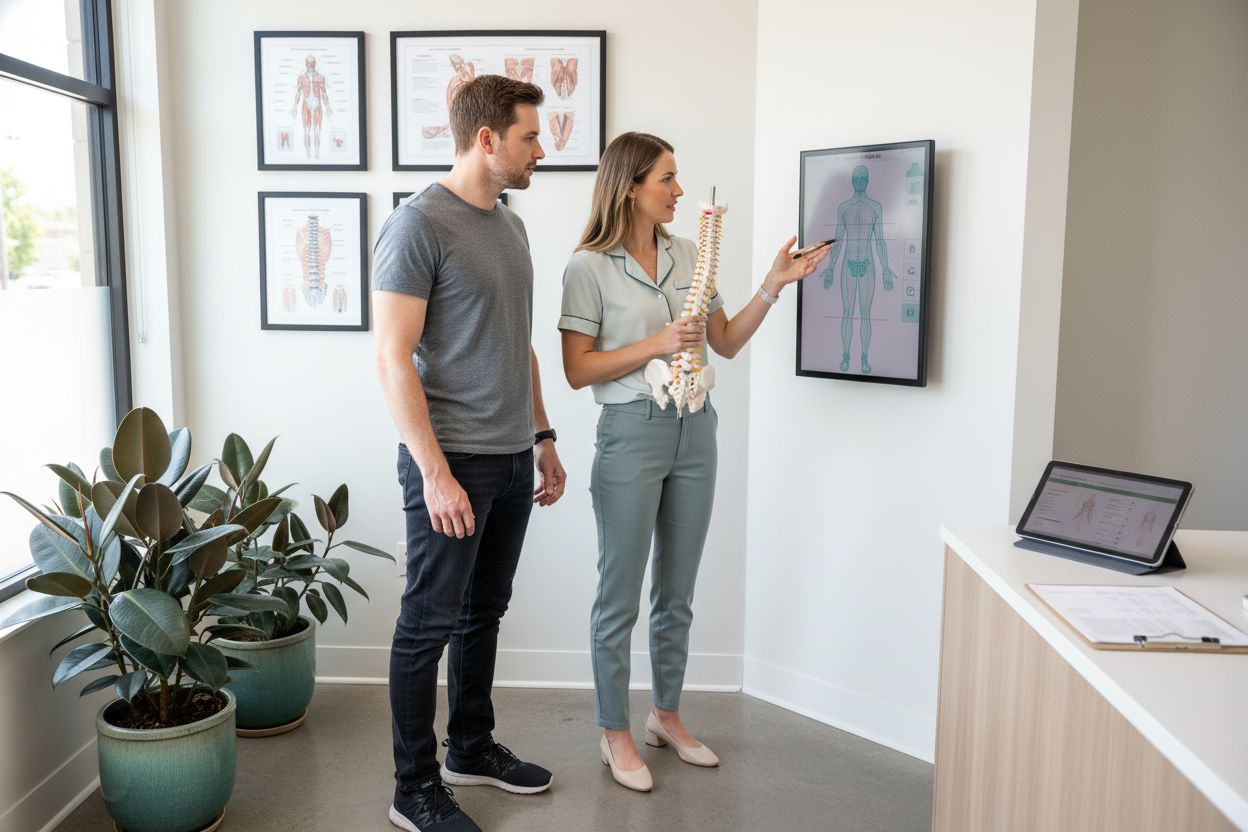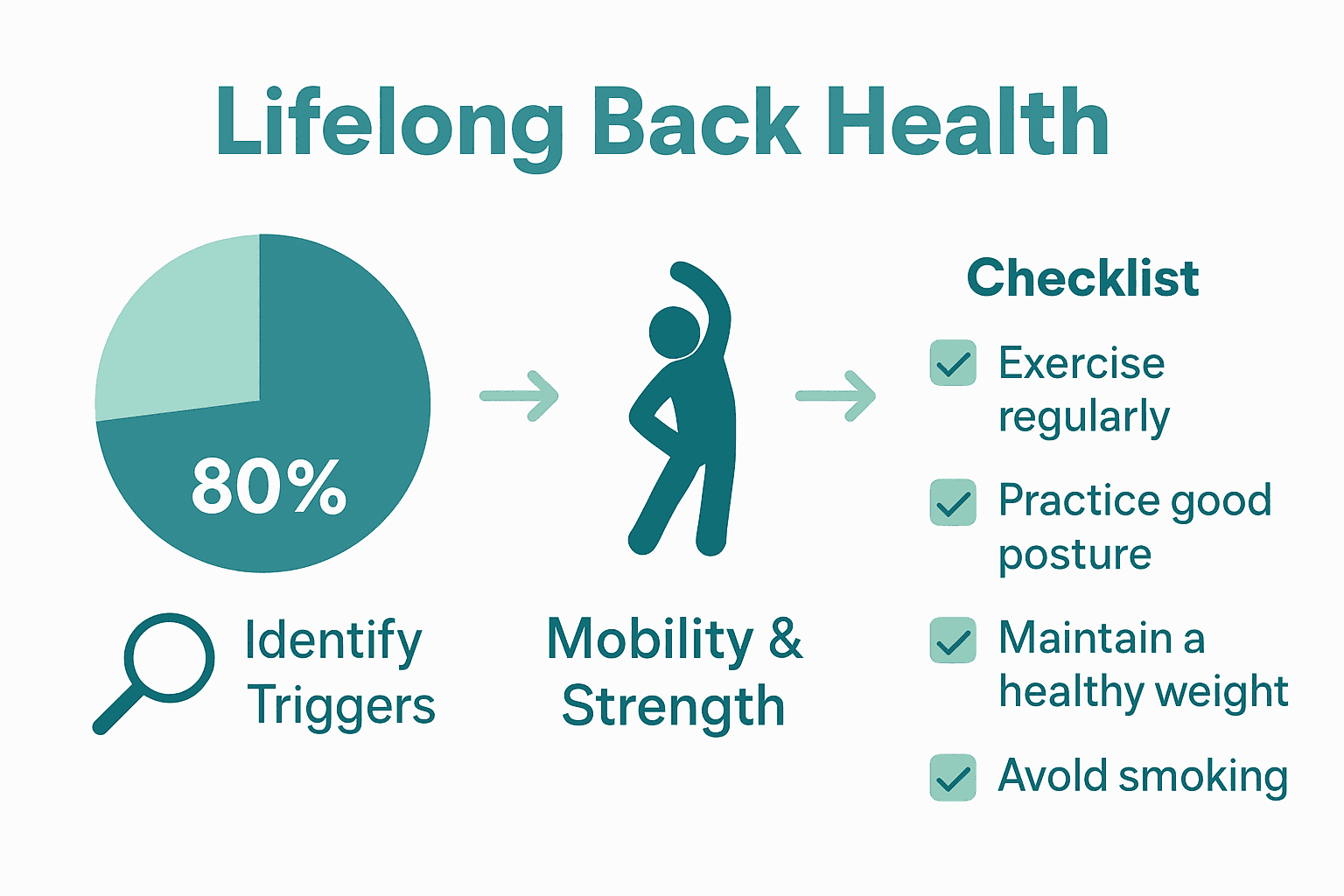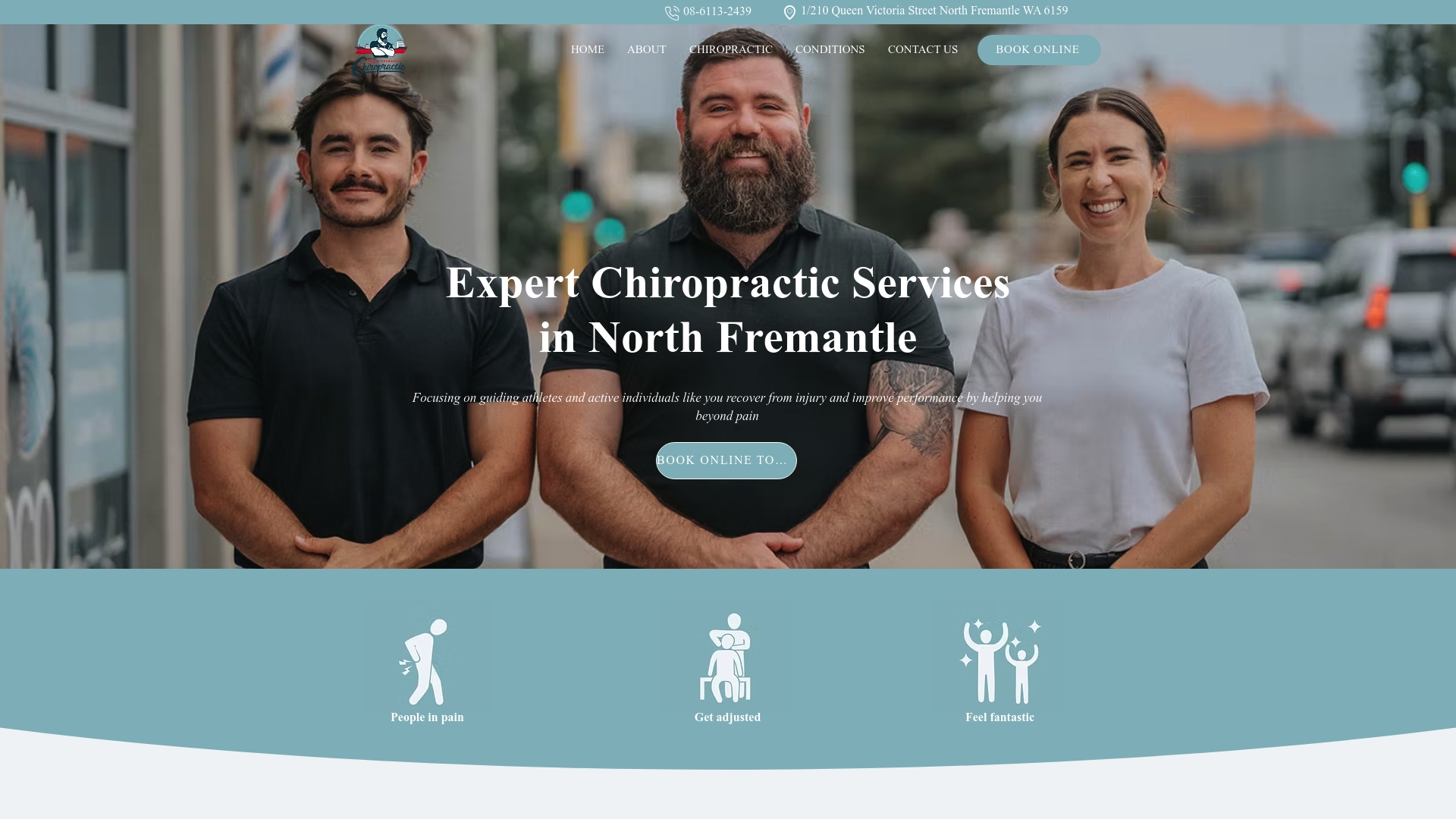How to Manage Back Pain Naturally for Lifelong Strength
- Dr Nathan Bridger
- 7 days ago
- 7 min read

Back pain will affect up to 80 percent of people at some point in their lives. This discomfort can turn simple tasks into daily struggles, making it harder to work, sleep, or enjoy time with your family. By learning how to read your body’s signals and making thoughtful adjustments, you can ease pain and regain your strength. These proven steps help you move better, feel stronger, and protect your back from future problems.
Quick Summary
Key Point | Explanation |
1. Track movement and pain triggers | Observe daily activities for pain-causing movements to gather insights about your body. |
2. Optimize your posture daily | Make small adjustments to your posture for better spinal alignment and reduced discomfort. |
3. Include mobility exercises in your routine | Perform specific stretches daily to maintain flexibility and relieve back tension. |
4. Build strength progressively | Focus on functional strength exercises, gradually increasing intensity to support spinal health. |
5. Monitor progress consistently | Track symptoms and emotional responses regularly, adjusting your recovery strategies as necessary. |
Table of Contents
Step 1: Assess your movement and pain triggers
Your body speaks a unique language of movement and discomfort. Understanding this language means carefully tracking which activities spark pain and which support your strength and recovery.
Start by becoming a detective of your own body. Spend a week observing how different movements impact your back. Ambulance Victoria’s patient information suggests watching for specific triggers like twisting, lifting, or prolonged sitting.
Grab a simple notebook or use your phone to track patterns. Record activities that cause discomfort like:
Morning stiffness after sleeping
Pain when bending forward
Discomfort during specific work tasks
Challenges with lifting groceries or children
According to Healthdirect Australia, keeping active is crucial. Gentle movements like walking or swimming help you understand your body’s signals without causing additional strain.
Pro Tip: Move slowly and mindfully. Pain is information not punishment.
Remember your goal is gathering data about your body. This detective work sets the foundation for creating a personalised movement recovery strategy that supports your strength and reduces pain.
In the next step, you will use these insights to develop a targeted approach to managing and preventing back discomfort.
Step 2: Optimise your posture and daily routines
Your daily posture is like a silent conversation between your muscles, spine and overall wellbeing. By making small intentional adjustments, you can transform how your body feels and functions.
According to Healthdirect Australia, maintaining a neutral spine position is key. Think of your spine like a gentle S curve that needs balanced support throughout the day. This means paying attention during work, driving and even relaxing at home.
Start with your workspace. Set up an ergonomic environment that supports your natural body alignment. Position your computer screen at eye level, use a chair with proper lumbar support, and keep your feet flat on the floor. Better Health Channel Victoria recommends regular movement to prevent muscle fatigue and spinal strain.
Quick posture reset strategies include:
Standing up every 30 minutes
Doing gentle shoulder rolls
Checking your neck alignment
Stretching your hip flexors
Pro Tip: Your body gives constant feedback. Listen and respond before discomfort becomes pain.
Remember posture isnt about being rigid its about creating fluid support for your body. Small consistent adjustments build long term strength and comfort.

In the next step, youll learn specific exercises to reinforce these posture principles and create a resilient back support system.
Step 3: Incorporate targeted mobility exercises
Mobility is your body’s secret weapon against back pain. Think of these exercises as a daily tune up that keeps your muscles flexible, joints happy and your spine resilient.
Healthdirect Australia recommends combining low impact activities with strategic stretching to support your back muscles and improve overall movement quality. This means creating a routine that gently challenges your body without overwhelming it.
Drawing from Australian Institute of Fitness recommendations, here are some powerhouse mobility exercises:
Child’s Pose: Gentle spinal decompression
Downward Dog: Full body stretch and spine alignment
Pigeon Pose: Hip and lower back release
Supine Twist: Spinal rotation and muscle relaxation
Wide Legged Forward Fold: Hamstring and back stretch
Aim to spend 10 to 15 minutes daily working through these movements. Start slowly and listen to your body. The goal is smooth fluid motion not pushing into pain.
Here’s a summary of recommended back mobility exercises and their benefits:
Exercise | Primary Focus | Key Benefit |
Child’s Pose | Spinal decompression | Relieves tension |
Downward Dog | Full body stretch Spine | Improves flexibility |
Pigeon Pose | Hips Lower back | Releases tight muscles |
Supine Twist | Spinal rotation | Promotes relaxation |
Wide Legged Forward Fold | Hamstrings Back | Increases range of motion |
Pro Tip: Breathe deeply during stretches. Your breath helps muscles release tension.
Consistent mobility work transforms how your body moves and feels. Regular practice creates long term resilience and reduces the likelihood of future back issues.
In the next step, youll learn how to integrate strength training to further support your back health and performance.
Step 4: Build functional strength safely
Building strength is about creating a resilient body that moves with confidence and supports your everyday activities. Its not about lifting massive weights but developing smart functional muscle groups that protect your spine.
According to Healthdirect, progression is key. Start with gentle exercises and gradually increase intensity through movements like bodyweight squats, lunges and core stabilisation work. Think of strength training as building a robust support system for your spine.
The Australian Commission on Safety and Quality in Health Care recommends a progressive approach to physical activity. This means listening to your body and advancing slowly.
Key functional strength exercises include:
Bodyweight squats
Glute bridges
Bird dog holds
Planks with proper form
Walking lunges
Pro Tip: Quality trumps quantity. Focus on perfect technique over repetitions.
Begin with 2 to 3 sets of 8 to 12 repetitions. Pay attention to your form and stop if you feel sharp pain. Consistency matters more than intensity when rebuilding strength.
Strength training is your pathway to a more resilient back. By building muscle support systems gradually you create long term protection against future injuries.
In the next step youll learn how to integrate these techniques into a sustainable wellness routine.
Step 5: Monitor progress and adjust strategies
Your back health journey isnt a straight line. Its a dynamic process of continuous learning and adaptation. Tracking your progress helps you understand what works and when you need to make smart adjustments.
Healthdirect recommends creating a comprehensive tracking system that goes beyond just physical symptoms. This means monitoring not just pain levels but also your emotional response flexibility and overall activity tolerance.
Start by establishing a weekly check in routine. Document key metrics like:
Pain intensity and frequency
Range of motion improvements
Sleep quality
Stress levels
Exercise performance
According to the Clinical Care Standard, ongoing reassessment is crucial. Some warning signs that suggest you should seek professional guidance include:
Pain lasting more than a few weeks
Numbness or tingling
Significant reduction in mobility
Unexplained weight loss
Changes in bladder or bowel function
Pro Tip: Use a simple journal or smartphone app to track your progress consistently.
Remember healing is not linear. Some weeks will feel incredible while others might challenge your patience. Approach your recovery with curiosity and compassion.
Your commitment to understanding your body creates the foundation for long term back health and resilience.

From Pain Triggers to Real Strength: Make Your Back Recovery Personal
You have explored how tracking movement triggers, building mobility and forming new routines can lead to natural, lifelong back strength. Still finding it hard to make real progress or worried about pain returning during everyday activities? At North Fremantle Chiropractic, we understand that fixing pain is just the beginning. Our team specialises in hands-on, movement-based care designed for your unique lifestyle and fitness goals. We use many of the same concepts from the article, including functional strength and targeted mobility, but tailor them for you so you can conquer your day, not just your pain.

If you want expert support in building real resilience and making every day feel like progress, now is the time. Book your first appointment at North Fremantle Chiropractic and discover how our results-driven, energising sessions can help you move better, feel stronger and get back to doing what you love. Your next step to lifelong back strength starts here.
Frequently Asked Questions
How can I assess my movement and pain triggers for back pain?
Begin by tracking the activities that cause discomfort or support your recovery. Spend a week noting any patterns, such as pain during bending or lifting, and use a notebook or your phone to document your observations.
What daily routines can I optimise to improve my posture and reduce back pain?
To enhance your posture, make small adjustments in your workspace, such as keeping your computer screen at eye level and using a chair with proper lumbar support. Aim to stand up and stretch every 30 minutes to prevent muscle fatigue and maintain spinal alignment.
Which mobility exercises should I incorporate to manage back pain naturally?
Incorporate stretches like Child’s Pose, Downward Dog, and Pigeon Pose into your daily routine. Aim for 10 to 15 minutes of mobility exercises each day to improve flexibility and support your spine.
How do I build functional strength to support my back health?
Focus on bodyweight exercises such as squats, glute bridges, and planks to develop strength safely. Start with 2 to 3 sets of 8 to 12 repetitions, ensuring your technique is correct to avoid injury while building a supportive muscle foundation.
How can I monitor my progress in managing back pain?
Track your progress by documenting key metrics like pain intensity, flexibility, and exercise performance on a weekly basis. Use a simple journal or app to help identify improvements and potential areas needing adjustment, ensuring a clearer understanding of your recovery journey.
What signs indicate I should seek professional help for my back pain?
If you experience persistent pain lasting over a few weeks, numbness, significant mobility reduction, or changes in bladder or bowel function, it’s important to seek professional guidance. Keep an eye on your symptoms and consider consulting a healthcare provider if these issues arise.
Recommended
